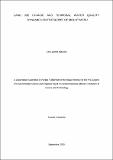| dc.description.abstract | This work reports on the results obtained following the study on the land use change and
temporal water quality change in rivers of the slopes of Mount Meru in Northern Tanzania
between 2015 and 2016. Satellite images collected from United States Geological Survey
(USGS) were used to model the land use change using ArcGIS and IDRISI software. Also,
419 water samples and two (2) rocks samples were collected from various geo-referenced
points and assessed for sixteen (16) water quality changes using standard methods for water
and wastewater from American Public and Health Association (APHA). The stable isotope
studies were done at the University of Waterloo stable isotopes laboratory using the Los
Gatos Research Laser processes analyzer with Integrated Cavity Output Spectroscopy (LGRICOS™).
The study showed significant land use changes in the area in every ten (10) years over a
period of thirty (30) years such that, there is an increase in human settlement from 74.2 km
2
(1986) to 261.2 km
2
(2016), decrease in agricultural land from 545.8 km
2
to 531.5 km
2
(2016). Also, in similar years the bush-land decreased from 372.3 km
2
(1986) to 158.4 km
2
(2016) in favour of increase of settlement. Moreover, the mixed forest were improved from
139.7 km
2
(1986) to 116.0 km
2
(2016) whereas the water bodies decreased significantly from
14.0 km
2
(1986) to 4.2 km
2
(2016). In addition, the water quality in rivers deteriorated due to
increased human activities, poor performing Wastewater Treatment Systems (WTS) which
discharge its effluents in rivers, and bad agricultural practices. Few sampling points in rivers
had Biochemical Oxygen Demand (BOD),
NO
3
and Total Soluble Phosphate (TSP) levels
higher than the World Health Organization (WHO) standards of 10 mg/L, 50 mg/L and 0.1
mg/L, respectively. Fluoride contamination in Themi, Nduruma and Tengeru Rivers were
within the WHO and Tanzania Bureau of Standards (TBS) maximum acceptable limits of 1.5
mg/L and 4.0 mg/L, respectively. Maji ya Chai River showed the highest levels of fluorides
and dissolved organic matter of up to 69.01 ± 0.03 mg/L and 10 ± 0.2 mg/L, respectively,
which are higher than the WHO standards. The study confirmed the main source of fluorides
in water is rocks containing fluoride in which its leaching is favoured in alkaline
environment. Also the stable isotopes studies revealed the origin of Dissolved Organic Matter
(DOM) were plant materials and soil composites whereas
NO
3
originated from wastewater,
urea fertilizers, and animal manures. The major sources for coloured dissolved organic matter and fluoride contents in Maji ya Chai River were discovered at Kirurumu hill (M1) and Jamera (M2), respectively. | en_US |

